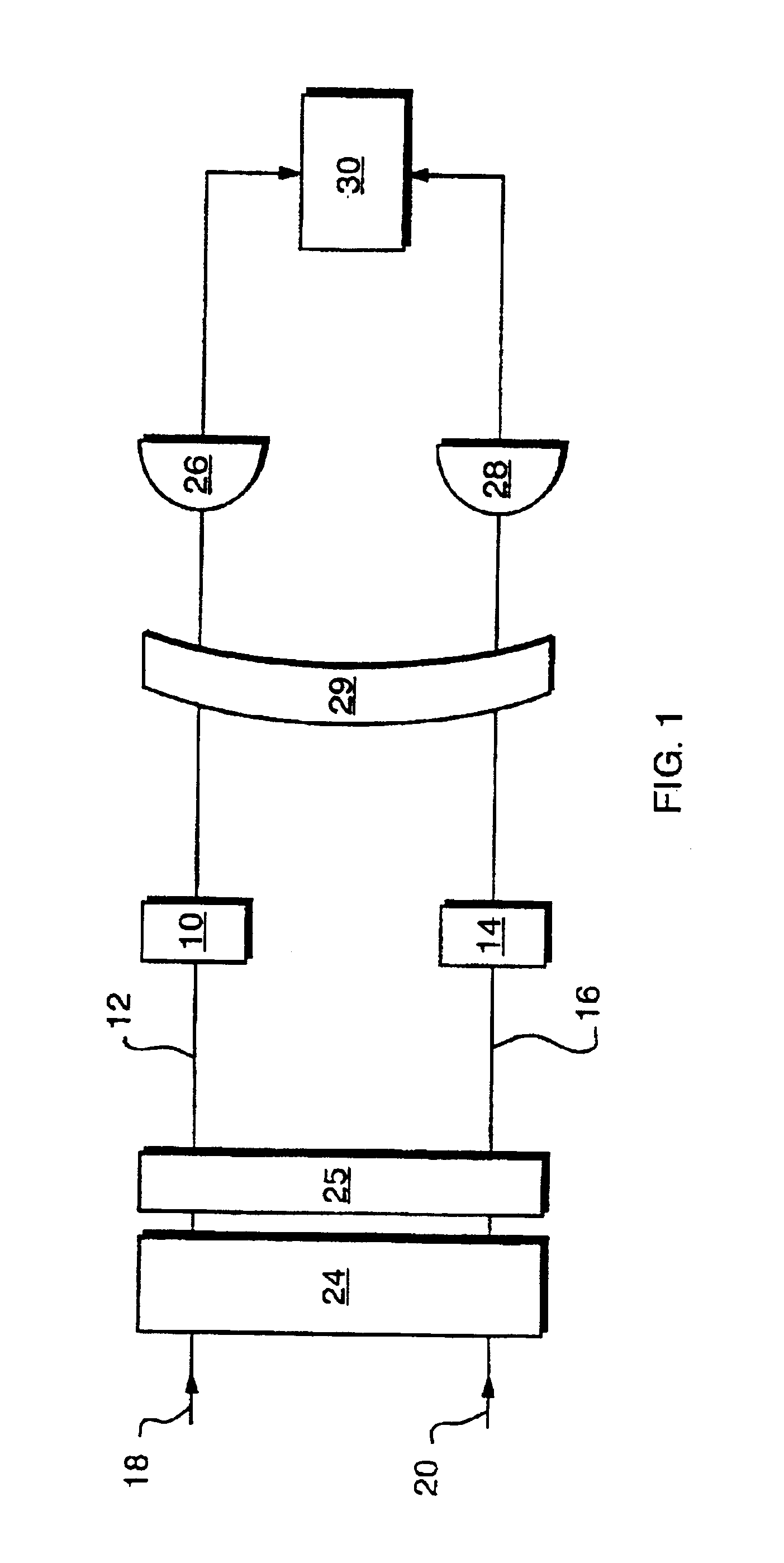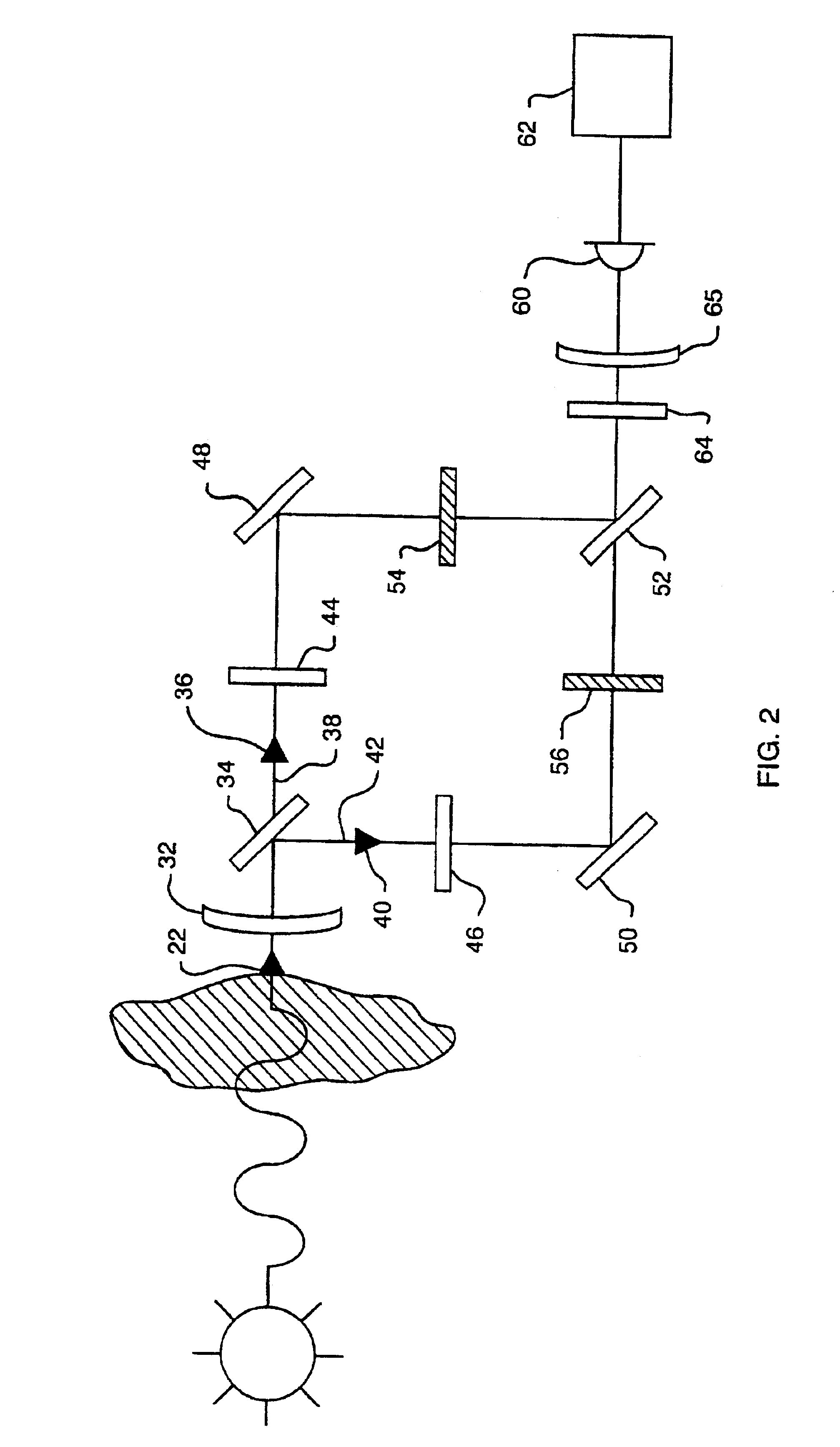Indeed, the potential release of dangerous substances is now a serious concern not only for the military, but for local governments as well.
This is an undesirable limitation, and can be dangerous if the target gas is toxic.
In addition, these systems are only capable of taking measurements in a point-wise fashion, such that numerous measurements are required to determine the boundaries of a chemical cloud.
The SAW
system is also portable and offers the exceptionally high sensitivity of 0.2 mg / m3, but lacks specificity and cannot determine the specific identity of a gas (i.e., it can only determine any of a certain number of gases may be present).
Consequently, they are extremely complex and expensive, require highly trained personnel for operation, and provide an undesirably limited
field of view (FOV) (which is delimited in such systems by the
divergence of the
laser beam).
In addition to these disadvantages, the filter and
detector components of the Air Force's LARS CO2 DIAL
system must be cooled in a
liquid nitrogen environment.
Accordingly, the
signal is weaker than that of the DIAL systems and the range is limited.
The main
disadvantage of FTIR systems, including the RSCAAL system, is that they depend on a complete spectral scan followed by detailed analysis of the spectrum.
To accomplish that scan, the system requires a complex, highly refined mechanical tunning arrangement which is difficult to make sufficiently rugged for field applications.
However, they also require longer scans and much larger data storage and
processing capabilities than multispectral-based systems, and therefore are less useful for operation by untrained personnel or from fast moving platforms.
But biasing the acousto-optic element during the tuning process causes the image to shift slightly, thereby complicating correlation between images obtained at different wavelengths.
However, fielding a Fabry-Perot filter is complicated by the need for good alignment and spacing control between the moving mirrors.
But cross talk between its spectral images can compromise its specificity.
The time required to acquire these images is usually limited by the maximum imaging rate of available FPAs, which presently stands at ≦50 Hz.
The primary drawback of GFCRs is the need for the sensor to include a
cell containing the sample species, which may present a
hazard when the sensor is to be used for the detection of toxic chemicals or chemicals that are difficult to
handle.
In addition, the requirement of a separate
cell for each target chemical results in a bulky detector.
Moreover, the need to mechanically switch the cells in and out of the FOV significantly reduces system reliability and speed, and may prevent the imaging of proliferated chemicals, such as gas clouds or liquid spills, due to a loss of registration between consecutive images.
Although this approach avoids the unreliability associated with mechanically switching between the cells, it is undesirably complex and expensive, requiring the use of a polarization modulator, two polarization beam-splitters, and a
waveplate.
In addition, the performance of available polarizing
beam splitters in the 8-13.3 μm spectral range presently is not sufficient to develop a sensitive detector of the design of the '797 patent for use in the 8-13.3 μm range.
While attempting to address this
disadvantage, however, the
grating-based design of the '571 patent introduces a number of additional disadvantages.
The slit is also used to reduce interferences by
stray light, to which the
grating-based system is particularly susceptible.
Without such a slit, the system loses some of its spectral resolving capabilities.
Consequently, the light gathering capability or FOV of the
grating-based GFCR system is limited by the
slit width.
The slit required by the design of the '571 patent also prevents the possibility of imaging the
spatial distribution of chemical clouds.
Given the
optics required, the fact that the system is sensitive to
optical alignment between the grating and the slit, and the fact that the system requires sufficient
optical path for the proper grating dispersion to develop (which may require up to several centimeters of distance between the grating and slit), the grating-based GFCR system clearly is not capable of
miniaturization.
A significant additional
disadvantage, however, is that the need for a combination of a concave grating and
spatial filter assemblies renders the system complex and cumbersome.
Although the technique of the '654 patent purports to provide well-defined spectral signatures, as well as capabilities of imaging preprogrammed species, it is exceptionally complex and, depends heavily on fine
optical alignment which can affect the
spectral resolution and the registration between images that are designed to represent the species itself and images that are representative of its background.
This approach is disadvantageous, however, as it depends on an exceptionally
broad bandwidth, which results in an undesirably low specificity.
In addition, the Althouse, et al. design suffers from undesirably low sensitivity because it fails to recognize the need for a
background subtraction and normalization technique.
Disadvantageously, the design requires that the filters be cryogenically cooled.
In addition, the design does not provide for methods to correct for the effects of
background radiation or emission, or absorption by atmospheric or other background species.
In addition, the use of moving filters inherently leads to a loss of registration between the images obtained through the two different filters, thereby preventing the possibility of subtracting one image from the other.
The Wimmers, et al. method also does not contemplate correcting for background interferences.
 Login to View More
Login to View More  Login to View More
Login to View More 


